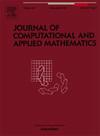无界区域中扩散-粘性波动方程的有效且保持耗散的Hermite谱伽辽金方法
IF 2.6
2区 数学
Q1 MATHEMATICS, APPLIED
Journal of Computational and Applied Mathematics
Pub Date : 2025-03-30
DOI:10.1016/j.cam.2025.116652
引用次数: 0
摘要
由扩散-粘性波理论导出的扩散-粘性波方程(DVWE)通常用于描述流体饱和介质中频率相关的地震反射,在地震勘探中得到了更广泛的应用。在Ling and Mao, 2023中,为了避免人为反射和截断误差,我们在无界域中考虑了DVWE,建立了它的适定性和正则性,并提出了用于空间离散化的Hermite谱伽辽金近似。然而,对于时间离散化,采用显式龙格-库塔格式,由于稳定性导致时间步长受到极大限制。为了解决这一问题,本文提出了两种二阶隐式(Crank-Nicolson和BDF2) Hermite谱方法,并证明了所提格式是无条件能量稳定的,进一步证明了其收敛性。此外,对于二维情况,我们开发了一种具有O(Nd+1)(其中N为每个方向的自由度,d为空间维度)计算成本的高效算法。特别地,对于常系数的情况,我们使用矩阵对角化技术,而对于变系数的情况,我们使用预条件共轭梯度法。最后,我们给出了几个数值例子来验证我们的理论结果,并证明了所提出方案的有效性和效率以及其他良好的性能。本文章由计算机程序翻译,如有差异,请以英文原文为准。
Efficient and dissipation-preserving Hermite spectral Galerkin methods for diffusive-viscous wave equations in unbounded domains
The diffusive-viscous wave equation (DVWE) resulting from the diffusive-viscous wave theory is usually used to describe frequency-dependent seismic reflections in fluid-saturated media, leading to a wider application in seismic exploration. In a previous work (Ling and Mao, 2023), we considered the DVWE in unbounded domain to avoid artificial reflections and truncation errors, and then established its well-posedness and regularity as well as developed a Hermite spectral Galerkin approximation for the space discretization. However, for the time discretization, an explicit Runge–Kutta scheme is employed resulting an extremely restricted time step due to the stability. In the present work, to resolve this issue, we develop two second-order implicit (Crank–Nicolson and BDF2) Hermite spectral methods and show that the proposed schemes are unconditionally energy stable and further establish the convergence. Furthermore, for the two-dimensional case, we develop an efficient algorithm with (where is the degree of freedom of each direction and is the space dimension) computational cost. In particular, we use the matrix diagonalization technique for the cases of constant coefficients while we employ the preconditioned conjugate gradient method for the cases of variable coefficients. Finally we provide several numerical examples to verify our theoretical results and to demonstrate the effectiveness and efficiency along with other good behavior of the proposed schemes.
求助全文
通过发布文献求助,成功后即可免费获取论文全文。
去求助
来源期刊
CiteScore
5.40
自引率
4.20%
发文量
437
审稿时长
3.0 months
期刊介绍:
The Journal of Computational and Applied Mathematics publishes original papers of high scientific value in all areas of computational and applied mathematics. The main interest of the Journal is in papers that describe and analyze new computational techniques for solving scientific or engineering problems. Also the improved analysis, including the effectiveness and applicability, of existing methods and algorithms is of importance. The computational efficiency (e.g. the convergence, stability, accuracy, ...) should be proved and illustrated by nontrivial numerical examples. Papers describing only variants of existing methods, without adding significant new computational properties are not of interest.
The audience consists of: applied mathematicians, numerical analysts, computational scientists and engineers.

 求助内容:
求助内容: 应助结果提醒方式:
应助结果提醒方式:


